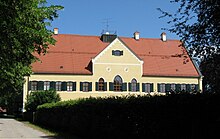Laufzorn Castle
Laufzorn Castle is a castle in the Laufzorn district of the Upper Bavarian municipality of Oberhaching . The building is registered as a monument in the Bavarian List of Monuments .
History and architecture
At the beginning of the 16th century, Duke Wilhelm IV had a ducal Schwaige built. Between 1616 and 1619, Duke Albrecht der Leuchtenberger (1584–1666), a brother of the reigning Duke Maximilian I , had a new two-storey main house built across the Schwaige. This unfortified Renaissance complex was typologically similar to the manorial main building built by his brother from 1617 in Schleissheim (today: Old Castle ) and was influenced by his knowledge of Italian villa buildings. A flight of stairs led up to the manorial first floor. Since then the property has been used primarily as a hunting lodge; Duke Albrecht regularly spent the summer in Laufzorn. From 1616 the Trinity Chapel was built opposite the main building. In 1670 Albrecht's nephew Maximilian Philipp inherited the property, had it structurally expanded and used it until his death in 1705.
Later it was the seat of a Hofmark . From 1760 Laufzorn was given as a fief by the House of Wittelsbach, so it was no longer used. Fiefdom holder from 1760 to 1762 was Baron Philipp Reinhard von Klingenberg (1720–1762), Bavarian chamberlain , officer and first commander of the Bavarian Cadet Corps , who was also buried in the castle chapel (which had not existed since 1803). A late Baroque redesign was planned, for which Lieutenant Johann Nepomuk Pär was responsible and which was probably only partially implemented. From 1763 to 1784 the property was owned by Johann Georg Dominicus von Linprun .
In the 19th century, the owner changed frequently and, accordingly, the commercial use. The renaissance building from 1616 was partly renewed around 1860 in historicizing forms and renovated from 1991 to 1992. The Laufzorn estate, which knight Heinrich von Ranke acquired in 1860 , included a brickworks that was connected to the Bavarian Maximiliansbahn (today Munich – Holzkirchen railway ) by a small train . Since the 1980s, the property has been used primarily for agriculture again.
The core of the Renaissance building from 1616 including the steep gable building with a dwelling on both sides and the double flight of stairs has been preserved to this day.
literature
- Georg Paula , Timm Weski: District of Munich (= Bavarian State Office for Monument Preservation [Hrsg.]: Monuments in Bavaria . Volume I.17 ). Karl M. Lipp Verlag, Munich 1997, ISBN 3-87490-576-4 , p. 166 .
- Kristina Dietrich: The hunting lodge Laufzorn. In: Arx 12 (1990), 2, pp. 573-576. (authoritative article)
- Georg Dehio (founder); Ernst Götz u. a. (Editor): Handbuch der Deutschen Kunstdenkmäler, Bavaria IV: Munich and Upper Bavaria. Munich / Berlin: Deutscher Kunstverlag, p. 642; ISBN 3-422-03115-4 .
- Andrea Hirner: Fresh and fun place. Sheep, bricks, horses: the former Wittelsbacher Gut Laufzorn has an eventful history. In: Our Bavaria. November 2014, Volume 63 No. 11, pp. 6–11.
Web links
Individual evidence
- ↑ List of monuments for Oberhaching (PDF) at the Bavarian State Office for Monument Preservation. Retrieved January 31, 2019 (monument number D-1-84-134-40 )
- ↑ Anton von Schönhueb: History of the Royal Bavarian cadet corps: From original sources written for the 100th jubilee celebration , Munich 1856, page 27
- ↑ Friedrich Teicher: The Royal Bavarian Cadet Corps: from the foundation to the present , Munich 1889, page 119
Coordinates: 48 ° 0 '54.9 " N , 11 ° 33' 14.7" E



